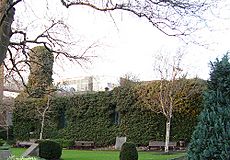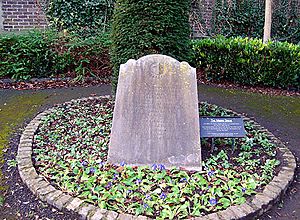St. Kevin's Church, Camden Row, Dublin facts for kids
St. Kevin's Church (also known as Eaglais Naomh Caoimhín in Irish) was a historic church in Dublin, Ireland. It stood in what is now St. Kevin's Park, Camden Row. People know it existed as far back as the 1200s. After a big change in religion called the Reformation, it became a Protestant church. The first church was replaced around 1750. This newer church closed in 1912 and is now just ruins. Both churches were named after Kevin of Glendalough, a famous Irish saint. There's also another St. Kevin's Church, a Catholic one, nearby on Harrington Street.
Quick facts for kids St. Kevin's Church |
|
|---|---|

St. Kevin's Church and Churchyard
|
|
| Lua error in Module:Location_map at line 420: attempt to index field 'wikibase' (a nil value). | |
| Location | Camden Row, Dublin |
| Country | Ireland |
| Denomination | Church of Ireland |
| Previous denomination | Roman Catholic |
| Membership | 73,000 (civil parish in 1901, United Parish of St. Peter and St. Kevin) |
| History | |
| Former name(s) | Eaglais Naomh Caoimhín |
| Status | Parish church, since 1680 chapel-of-ease to St. Peter's |
| Founded | Pre-13th century |
| Dedication | Kevin of Glendalough |
| Cult(s) present | Diarmaid Ó hUrthuile |
| Architecture | |
| Functional status | Closed, part of public park |
| Heritage designation | Preservation order |
| Closed | 1912 |
| Administration | |
| Parish | Parish of St. Peter (United Parish of St. Peter and St. Kevin) |
Contents
The Story of St. Kevin's Church
The first time anyone wrote about St. Kevin's Church was in 1226. It was a bit outside the main city walls of Dublin. It was also in the part of the city where people spoke Irish. The church was close to a group of monks living near what is now Aungier Street.
From the 1200s, the church was part of the Manor of St. Sepulchre. This area was directly controlled by the Archbishop of Dublin. In 1967, archaeologists dug up the area. They found some old graves and coins from the Middle Ages. The ruined church you see today was built around 1750. It stands on the very old foundations of the medieval church.
Archbishop Dermot O'Hurley's Burial
The church is the burial place of Archbishop Dermot O'Hurley. He was removed from a large grave and buried here. This happened after he was quickly put to death on June 20, 1584. He was executed at Hoggen Green.
Archbishop O'Hurley became the Archbishop of Cashel in 1581. He was arrested when he came back to Ireland. He was held in Dublin Castle. In 1992, Pope John Paul II honored Archbishop O'Hurley and 17 other Irish Catholic Martyrs.
Wars and Changes at the Church
During the Irish Confederate Wars (1641–1649), soldiers from Wicklow sometimes came onto the church lands. Trenches were dug near the church to help protect Dublin. But the Irish clans were still able to take cattle and horses. They also sometimes took merchants who were in the wrong place. They carried everything back to Wicklow. This continued even when there were cease-fires. The Battle of Rathmines finally ended these raids.
In 1698, during the time of the Penal Laws, the church was offered to the Huguenot community. They were a group of French Protestants. They used it as a place to worship and a cemetery. However, Catholic people continued to use the graveyard for burials until the late 1800s.
St. Kevin's Parish and Community
After the Reformation, the Church of Ireland managed the parish of St. Kevin. This area stretched south to places like Rathmines and Harold's Cross. In 1680, the parish of St. Kevin was taken over by St. Peter's. This happened because there weren't enough church leaders in Dublin at the time.
St. Kevin's Church became a "chapel of ease" for St. Peter's. This meant it was a smaller church that helped serve the larger parish. A school for the parish was also set up nearby on Camden Row. In 1901, the area of St. Peter's parish (which included St. Kevin's) had about 73,000 people. By 1971, the population was around 43,000.
The last church leader for St. Kevin's was Thomas Chatterton Hammond. He started in 1910. You can see his name on wedding papers from late 1909.
Who is Buried at St. Kevin's Cemetery?

In the 1600s and 1700s, many important people who lived in the areas south of Dublin were buried here. Even though it became a Protestant cemetery after the Reformation, Catholic people and Quakers also used it for burials.
Some of the notable people buried here include:
- Rev John Austin S.J. (1717–1784), who helped start Catholic education in Ireland.
- Jean Jasper Joly (1740–1823), a captain in the Irish Volunteers during 1798.
- John Keogh (1740–1817), a close friend of Theobald Wolfe Tone.
- Hugh Leeson, a brewer. His family gave their name to Leeson Street.
Famous People Connected to St. Kevin's
Field Marshal The 1st Duke of Wellington was baptized in this church. He became famous for winning the Battle of Waterloo. The special bowl used for his baptism was given to Taney parish in Dundrum in 1912. This was when St. Kevin's Church closed. It is now in St. Nahi's Church there.
Reverend Stephen Jerome was the church leader in 1639. He was known as a great speaker and writer. After 1649, he became a special speaker at St Patrick's Cathedral. However, some people didn't like his strict religious views.
Legends and Ghost Stories
After Archbishop Dermot O'Hurley was put to death and secretly buried, his grave became a special place for local Catholic people. Many people visited his tomb. In 1609, because so many pilgrims were coming, the church was rebuilt. A new entrance was also made.
People believed many legends about his tomb. For example, in local Irish folklore, there are ghost stories about Archbishop Dermot O'Hurley. People say that on dark, stormy nights, passersby might see him. He is said to be performing a special church service over his grave in St. Kevin's churchyard. The stories say that when he reaches the most important part of the service, he and the altar disappear, leaving only darkness.
See also
- Portobello
- St. Peter's Church, Aungier Street, Dublin

